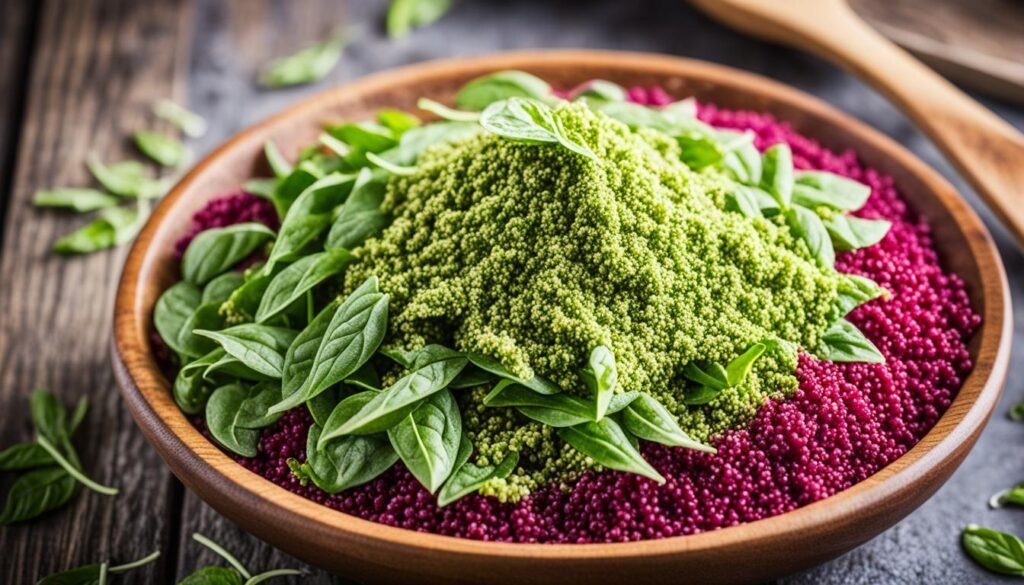Amaranth and Dietary Restrictions: A Friendly Guide

In today’s world, food sensitivities and intolerances are more common. Finding the right grains can be tough. But, what if there’s a grain that fits many diets and is packed with nutrients? Amaranth is that grain – it’s gluten-free, safe for many allergies, and super nutritious.
Are you wondering how amaranth can help with your dietary needs? Get ready for a journey that will open your taste buds and help you make better health choices.
Understanding SIBO: Causes, Symptoms, and Treatment
SIBO, or Small Intestinal Bacterial Overgrowth, happens when bacteria grow too much in the small intestine. This imbalance can cause bloating, gas, diarrhea, and stomach pain. It’s important to know about SIBO to manage it well.
What is SIBO?
SIBO means there’s too many bacteria in the small intestine. This can happen if your immune system is weak, if your digestive tract has problems, or if some medicines change your gut bacteria.
Symptoms of SIBO
SIBO can cause:
- Bloating and gas
- Diarrhea or constipation
- Abdominal pain or discomfort
- Malabsorption of nutrients, leading to deficiencies
- Fatigue and brain fog
Treatment Options for SIBO
There are ways to treat SIBO, like:
- Antibiotics: Antibiotics, especially rifaximin, can help reduce bacteria in the small intestine.
- Dietary changes: Eating less of certain carbs can help manage SIBO symptoms.
- Herbal therapies: Some herbs, like berberine and oregano oil, work as well as antibiotics.
- Probiotics: Certain probiotics can help balance gut bacteria.
- Elemental diet: Eating foods that are easy to digest can help control bacteria levels.
Combining these treatments often works best. It’s good to talk to a healthcare professional to find the right plan for you.

The Importance of Diet in Managing SIBO
Eating right is key to managing Small Intestinal Bacterial Overgrowth (SIBO) and stopping it from coming back. A diet for SIBO means cutting down on fermentable carbohydrates, or FODMAPs, which feed the bad bacteria. This diet helps ease symptoms and helps your gut heal.
Role of Diet in SIBO Management
The main aim of a SIBO diet is to limit the food that the bad bacteria like to eat. This can lessen gas, bloating, and other bad symptoms of SIBO. It also helps fix nutrient gaps and supports gut health, which is vital for handling this condition.
Foods to Avoid with SIBO
When you’re on a SIBO diet, avoid foods that make your symptoms worse. These include:
- Gluten-containing grains, such as wheat, barley, and rye
- Dairy products, especially those high in lactose
- High-FODMAP fruits and vegetables, like onions, garlic, and certain legumes
- Sugary and processed foods, which can feed the overgrown bacteria
SIBO-friendly Foods: What to Include in Your Diet
To help your gut and manage SIBO, add these foods to your meals:
- Low-FODMAP fruits and vegetables, such as berries, zucchini, and leafy greens
- Gluten-free, low-FODMAP grains like amaranth, quinoa, and rice
- Lean proteins, such as chicken, turkey, and seafood
- Healthy fats from avocado, nuts, and olive oil
- Probiotic-rich foods, including fermented vegetables and cultured dairy products (if tolerated)
By eating these foods and avoiding the bad ones, you can control your symptoms, improve nutrient absorption, and boost gut health.

An Introduction to Amaranth
What is Amaranth?
Amaranth is a versatile and nutrient-dense pseudocereal that has been around for centuries. Ancient civilizations like the Aztecs and Incas grew it. It’s gluten-free and full of protein, fiber, vitamins, and minerals. This makes it great for people with dietary restrictions.
Nutritional Profile of Amaranth
Amaranth is an ancient grain with a rich nutritional profile. It’s high in protein, with amounts from 13.1% to 21.0%. It also has a good amount of fiber, from 3.1% to 5.0%.
This pseudocereal is full of important vitamins and minerals. You’ll find calcium, magnesium, phosphorus, copper, and manganese in it.
Compared to other grains, amaranth has more protein, fiber, and certain minerals. It has up to 30% more protein than wheat and rice. Its fiber is three times that of wheat.

Amaranth’s unique nutritional profile makes it a great choice for gluten-free or plant-based diets. Its versatility and nutritional benefits have made it a popular superfood. It’s also seen as a sustainable crop for the future.
Health Benefits of Amaranth
Amaranth is a superfood that’s packed with nutrients. It supports your gut health, boosts nutrient absorption, and lowers the risk of chronic diseases. Let’s dive into why adding amaranth to your meals is a smart choice.
This grain is loaded with fiber. Fiber helps you stay regular and aids in managing your weight. Amaranth’s fiber keeps you feeling full, which can help you eat less and lose weight.
Amaranth is also full of antioxidants. These compounds fight off oxidative stress, lowering the risk of heart disease, cancer, and diabetes. Its antioxidants support a strong immune system and overall health.
Plus, amaranth is easy to digest and absorbs nutrients well. This means your body can easily use the vitamins, minerals, and other good stuff in amaranth. Adding amaranth to your diet ensures you get the nutrients you need to stay healthy.
The health perks of amaranth are clear. It’s great for your gut, helps with weight control, and more. This ancient grain is a superfood that should be part of a healthy diet. Find out how to add amaranth to your meals and enjoy its many benefits.
Amaranth and Dietary Restrictions
Amaranth is a great choice for people with different diet needs. It’s gluten-free, vegan, and allergen-friendly. This makes it perfect for those with celiac disease or other dietary restrictions.
Amaranth is great because it doesn’t have gluten. This is good news for people with celiac disease or gluten sensitivity. They can safely enjoy amaranth without worrying about gluten reactions.
It’s also a top pick for vegan and vegetarian diets. Amaranth is a plant-based protein source. It adds a lot of essential amino acids to meatless meals.
For people with food allergies or intolerances, amaranth is a safe choice. It’s not a common allergen like dairy or nuts. This makes it easy for many people to include in their diets.
| Nutrient | Amount per 1-cup serving (246g) | % Daily Value |
|---|---|---|
| Calories | 251 | – |
| Protein | 9.4g | 19% |
| Fat | 3.9g | 6% |
| Carbohydrates | 46g | 15% |
| Fiber | 5.2g | 21% |
| Iron | 5.2mg | 29% |
| Calcium | 116mg | 12% |
| Magnesium | 160mg | 40% |
| Manganese | 2.1mg | 105% |
| Phosphorus | 364mg | 36% |
In summary, amaranth is a great choice for people with dietary restrictions. It’s gluten-free, allergen-friendly, and packed with nutrients. It’s a great addition to any restricted diet.
Cooking with Amaranth
Amaranth is a versatile ingredient for both sweet and savory dishes. It has a unique texture and nutty flavor. Plus, it’s packed with nutrients, making it great for any kitchen. Cooking with amaranth can be fun and rewarding.
Amaranth Recipes
Amaranth is great for many recipes. You can use it in porridges, salads, baked goods, and main dishes. Here are some tasty ways to add it to your meals.
- Amaranth Porridge: Start your day with a nutritious amaranth porridge. Cook it with milk or a plant-based alternative. Then, add fresh fruit, nuts, and honey for a delicious breakfast.
- Amaranth Salad: Mix cooked amaranth with greens, veggies, and a tangy dressing. This salad is great as a main dish or side.
- Amaranth Granola Bars: Make your own granola bars with toasted amaranth, oats, nuts, seeds, and a bit of sweetener. They’re perfect for snacking on the go.
- Amaranth Falafel: Add amaranth to your falafel mix for more protein and texture. Serve it in a pita or on a salad.
- Amaranth Baked Goods: Use amaranth flour or grains in your baking. Try it in gluten-free cookies, muffins, or bread. It adds a nutty flavor and tender crumb.
These are just a few examples of what you can do with amaranth. It’s a versatile ingredient for many recipes. Try new things and see how you can use it in your cooking.
| Amaranth Nutrition Facts | Quantity (per 1 cup cooked) |
|---|---|
| Calories | 251 |
| Protein | 9.3 g |
| Carbohydrates | 46 g |
| Fat | 5.2 g |
| Fiber | 5 g |
Try out amaranth recipes to enjoy its health benefits and unique taste. This ancient grain is versatile and can make your cooking exciting. Let your creativity flourish with amaranth.
Growing Amaranth at Home
Amaranth is a versatile and resilient crop perfect for home gardens. It’s great for those into growing amaranth, home gardening, and wanting a sustainable crop of this ancient grain. It needs little soil and water, making it easy to grow in many places, from small city gardens to big suburban areas.
This plant belongs to the Amaranthus spp. family and is an annual. It grows 2-4 feet tall and 1-2 feet wide. It loves full to partial sun and moist, well-drained soil that’s a bit acidic. In summer and fall, it blooms with bright red flowers that turn into edible seeds and leaves.
To grow amaranth at home, follow these tips:
- Sow seeds after the last frost date, or start them indoors 3-4 weeks before the last expected frost.
- Provide at least 6 hours of direct sunlight per day and keep soil temperatures between 70-85°F (21-29°C) for best growth.
- Space plants 18 inches (46 cm) apart, thinning as needed for proper growth.
- Water regularly, especially in the early stages, and keep soil moist but well-drained.
- Harvest leaves anytime for a nutritious green, and collect seeds when flowers dry and turn brown.
Growing amaranth at home is rewarding for gardeners and cooks. It’s hardy, easy to care for, and versatile in the kitchen. By growing this ancient grain, you get a sustainable and nutritious food source. Plus, you help preserve this remarkable plant.
Amaranth: A Sustainable and Versatile Crop
Environmental Benefits of Amaranth
Amaranth is more than just a nutritious food. It’s also a sustainable and eco-friendly crop. This ancient grain has been around for centuries. It can grow in many climates, making it a key crop for fighting climate change.
Amaranth uses less water and soil than many crops. It can grow in tough conditions, which is great for areas with little rain. This crop is perfect for places struggling with water shortages, helping to lessen the effects of climate change.
It’s also good for the planet because it doesn’t need a lot of synthetic fertilizers or pesticides. This means it has a smaller carbon footprint than many other crops. It’s part of the move towards farming that’s better for the earth.
Amaranth is versatile, offering many ways to help the environment. It can act as a cover crop, preventing soil erosion and boosting soil health. Its ability to fix nitrogen also makes the soil more fertile.
By using amaranth, farmers and communities can create a more eco-friendly food system. This ancient grain is a powerful tool in the battle against climate change.
Incorporating Amaranth into a SIBO-Friendly Diet
Following a SIBO-friendly diet can be tricky, but amaranth is a great choice. It’s a nutrient-rich grain that’s gluten-free and low in FODMAPs. This makes it perfect for people with small intestine bacterial overgrowth (SIBO).
Amaranth is packed with vitamins, minerals, and fiber that are good for your gut. It’s high in protein and has all the essential amino acids. Plus, it’s a good source of magnesium, iron, and calcium.
To get the most out of amaranth, prepare it in ways that are easy on your stomach. Steaming, baking, or simmering amaranth can help make it easier to digest and less likely to trigger SIBO symptoms. Try adding it to breakfast porridges, salads, soups, or side dishes.
Remember to watch how much amaranth you eat. The Monash University Low FODMAP Diet app suggests a max of 1/3 cup (50 grams) per meal. This way, you can still enjoy amaranth’s benefits without upsetting your SIBO.
Adding amaranth to your diet can be tasty and good for your gut health. Look for recipes and cooking methods that use this versatile grain. This can help you manage your SIBO symptoms and enjoy meals that are both flavorful and nutritious.
Conclusion
Amaranth is a versatile and nutritious grain great for people with dietary restrictions, like SIBO. It’s gluten-free, vegan, and safe for those with allergies. Plus, it’s packed with nutrients and grown in a way that’s good for the planet.
If you’re on a SIBO-friendly diet or just want to eat healthier, amaranth is a top choice. It helps with digestion, gives you important nutrients, and supports farming that’s good for the earth. This makes it a great fit for many diets.
Adding amaranth to your meals means you get a grain that fits your dietary needs and boosts your health. You can cook it in many ways and it tastes great. Amaranth is perfect for anyone on a SIBO-friendly or restricted diet. Try it out and enjoy the benefits of this ancient superfood while helping the planet.
FAQ
What is SIBO (Small Intestinal Bacterial Overgrowth)?
SIBO is when too many bacteria grow in the small intestine. This can cause bloating, gas, diarrhea, and stomach pain.
What are the common symptoms of SIBO?
Symptoms of SIBO include bloating, gas, diarrhea, and stomach pain. Other symptoms are constipation, malabsorption, and nutrient deficiencies.
How is SIBO treated?
Treating SIBO often means taking antibiotics and using antimicrobial herbs. Changing your diet is also key. Eating foods that don’t cause fermentation helps manage the condition and prevent it from coming back.
What is a SIBO-friendly diet?
A SIBO-friendly diet means eating fewer fermentable carbohydrates (FODMAPs). It also means avoiding gluten, dairy, and other foods that can trigger symptoms. This helps starve the bad bacteria and helps your gut heal.
What is amaranth, and how is it beneficial for individuals with dietary restrictions?
Amaranth is a nutritious grain that’s been around for centuries. It’s gluten-free, vegan, and safe for people with allergies. This makes it perfect for those with dietary restrictions, like SIBO sufferers.
What are the key nutritional benefits of amaranth?
Amaranth is packed with protein, fiber, vitamins, and minerals. It’s also full of antioxidants. These nutrients support digestion, nutrient absorption, and overall health.
How can amaranth be incorporated into a SIBO-friendly diet?
Amaranth fits well in a SIBO-friendly diet because it’s gluten-free and low in FODMAPs. You can add it to many dishes, like porridges, salads, baked goods, and main courses. It’s a tasty way to manage SIBO symptoms.
Can amaranth be grown at home?
Yes, you can grow amaranth at home, even in small spaces. It’s a hardy crop that can be a sustainable food source. Growing it helps preserve this ancient grain.
What are the environmental benefits of growing amaranth?
Amaranth is good for the environment. It uses less water and soil, grows in many climates, and is resilient to climate change. This makes it a valuable crop for a sustainable future.






